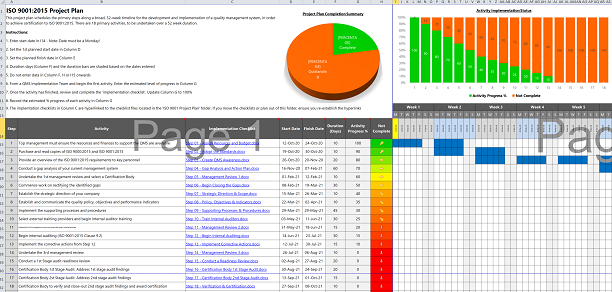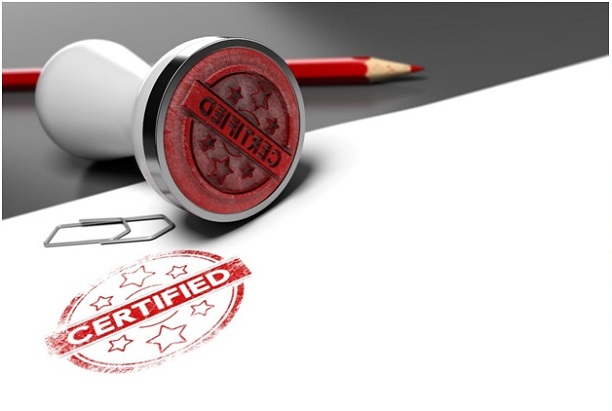You gain ISO 9001 certification in five easy steps; preparation, documentation, implementation, internal audits, and finally, certification.
Contents
- Preparation
- Documentation
- Implementation
- Internal Audit
- Certification
- ISO Project Plans [Template downloads]
ISO 9001 certification is a great way to help support and grow your business through adhering to global quality standards. To learn more about the steps, what the certification process is like and how long the certification process takes continue reading.
Our ISO 9001 Project Plan Template is proven to work.
There are three ways to prepare for ISO certification .
They all have their strengths and weakness, though one it proportionally better than the other two. The three approaches are:
An in-house approach means that your company is going to do the entire certification process by themselves without outside help. Meaning your company does the research, your company implements the proper changes to policy and structure, and your company does the review work.
It is the slowest of the three approaches to take effect, but it is ideal for smaller companies that have a unique inner office culture that wouldn’t respond well to outside influence.
It also has the highest probability of retaining certification after it is received because there is already a checks and balances system in place to make sure that standards are being maintained.
A hands-on consultant is an ISO 9001 certification expert that you hire to come into your company. They are responsible for making sure that your company meets the ISO 9001 certification standards. Once the certification is complete, they leave.
This is the fastest of the three proposed approaches. However, it has the lowest success rate, meaning it is less like for the company to retain its certification after the consultant leaves.
This is because the company had no direct involvement with acquiring the certification, so they are more likely to go lax when it comes to maintaining standards and policies they may not fully understand
A hands-off consultant is a combination of an in-house approach with a hands-on consultant. You again hire an ISO 9001 certification expert. However, they don't implement any of the changes themselves.
Your company's chosen project leader is responsible for making sure that the standards meet certification requirements.
The hands-off consultant is a happy middle ground. While the company's certification project leader doesn't have to learn about all of the ins and outs of the certification process they do have to learn how to maintain the standards, so the company will likely retain their certification after the consultant has finished their job.
Out of these three approaches, we recommend the in-house approach. While it does take the longest time, having the work done within the company by someone who already knows how the company works encourage compliance after the certification process concludes.
Our ISO 9001 Project Plan Template is proven to work.
ISO 9001 certification is a lot simpler than most expect. While they used to require additional documentation, the primary paperwork needed for an application now is the same you would submit in any business proposal.

Writing your documentation can be a daughnting part of the application process. To help you with 90% of the documentation, we recommend using a Quality Manual Template.
The Template includes everything you need for ISO 9001 documentation - quality policy, scope, what procedures you're planning to implement, flow charts, objectives, instructions for employees and additional forms that ISO 9001 certification may require.
Our Quality Manual Template is proven to work.
The most important thing to remember when drafting your application for certification is to write it for your company and its needs and circumstances. You want the writing to be clear and direct, try to be as detailed as possible. When formatting the layout, make it accessible and easy to read.

Each of the ISO 9001 clauses needs to be addressed and documented.
This is where an ISO 9001 Project Plan really will help.

Internal Audits are crucial yet straightforward elements of the ISO 9001 certification procedure. The internal audits are performed first during the certification process and then periodically after.
You can hire a sub-contractor to perform the audits, but it is encouraged for you to have the audits done in-house.
Internal auditing can also be an excellent way to train your employees in the implementation procedures. Understanding the exact expectations a specific process or system is supposed to conform to the employees will have a more in-depth understanding of the said process.
One other good thing about the internal auditing step of the application process is that it doesn't need to be completed in one go. You can break the internal auditing process into different parts and days depending on departments, if you want to cover a specific implementation procedure first, etc.

The final step is certification.
This is done through selecting your ISO certification auditor. They will visit and perform a 2-stage ISO certification audit to see if you are adhering to the ISO standards. If passed, you will receive your certification.
Once ISO 9001 certification is received, make sure you don't fall lax in your responsibilities. An auditor will continue to come once or twice a year. If you drop below standards, your certification will be revoked.
If you prepare like you should, doing the necessary reading and paperwork, and have all your employees put forth their best effort during the implementation process, certification should take from three to six months.
We recommend, when creating your project plan, to aim for six months. While it is easy to be overly eager and want to rush forward the certification, remember learning about the standards, why they are in place, auditing current procedures and implementing new processes is an essential part of gaining ISO 9001. ISO certification should be a long-term goal, not a short-term one.
ISO 9001 Implementation
Updated: 3rd Feb 2024
Author: Richard Keen

Richard is our Compliance Director, responsible for content & product development.
But most importantly he is ISO's biggest fanboy and a true evangelist of the standards.
Learn more about Richard
Don’t Try to Manage It All Alone!
Our ISO Auditors and Quality Manager Trainers have been in this industry for years, and since 2002 we’ve been providing thousands of small businesses and large corporations with the tools they need to get certified.
Instead of trying to create a project plan and checklist from scratch, use ours.
Before you invest all the hours reinventing the wheel, before you spend countless dollars outsourcing the task — try our templates.
| QMS ISO 9001 |
EMS ISO 14001 |
OH&S ISO 45001 |
|||
ISO 9001 Project Plan and Implementation Checklists |
A complete 18-step project plan for ISO 9001 using MS Excel.
Implementation checklists for each of the 18 steps, MS Word.
|
|
$39 USD |
||
ISO 14001 Project Plan and Implementation Checklists |
A complete 18-step project plan for ISO 14001 using MS Excel.
Implementation checklists for each of the 18 steps, MS Word.
|
|
|
$39 USD |
|
ISO 45001 Project Plan and Implementation Checklists |
A complete 18-step project plan for ISO 45001 using MS Excel.
Implementation checklists for each of the 18 steps, MS Word.
|
|
|
$39 USD |
|
ISO 9001 + ISO 14001 |
A complete 18-step project plan for ISO 9001 and ISO 14001.
Implementation checklists for each of the 18 steps, MS Word.
|
|
$39 USD |
||
ISO 9001 + ISO 45001 |
A complete 18-step project plan for ISO 9001 and ISO 45001 using MS Excel.
Implementation checklists for each of the 18 steps, MS Word.
|
|
$39 USD |
$39 USD |
|
ISO 9001 + ISO 14001 + |ISO 45001 |
An integrated 18-step project plan for
Implementation checklists for each of the 18 steps, MS Word.
|
|
$39 USD |
||
Pay by Credit Card, Debit Card, PayPal or Apple Pay.


|
Please read our Money Back Guarantee. |
Bought by Small Businesses and Large Corporations our templates have been sold online and CD since 2002.
Used by:
The Templates are used by first-timers following our step-by-step, clause-by-clause guidance documents; and experienced Quality Managers wishing to streamline and improve their existing documentation.
The application of our templates is scalable and generic; regardless of the size and type of organization. The elements that form the quality management system are the same.
1. Our customizable templates save you time and money by offering a streamlined process to create your quality documentation
2. They’ve got everything you need in one simple template
3. Proven to work our templates have helped thousands of businesses big and small achieve certification
4. Documents use styles to make reformatting and rebranding a breeze
5. Our templates are generalizable for any industry or sector. The application of our templates is scalable and generic; regardless of the size and type of organization.